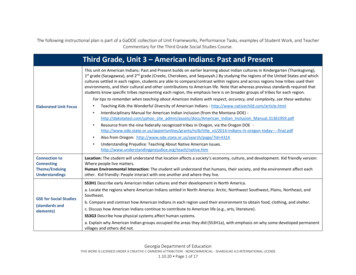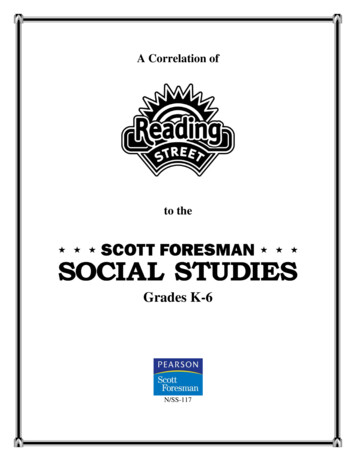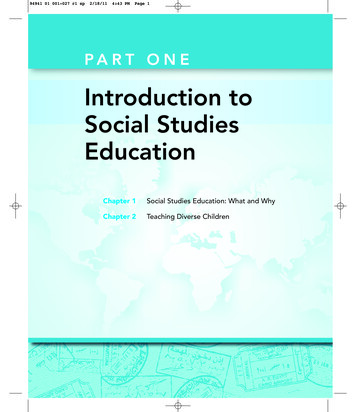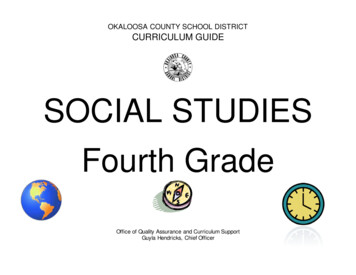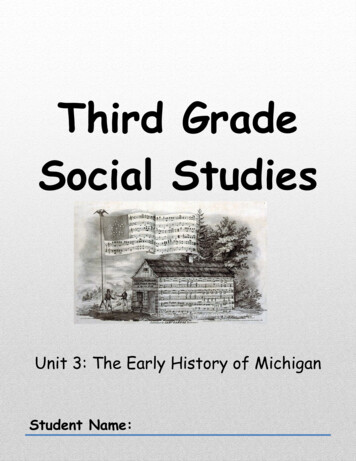
Transcription
Third GradeSocial StudiesUnit 3: The Early History of MichiganStudent Name:
rd3 Grade Michigan StudiesUnit 3: The Early History of MichiganBig Picture GraphicOverarching Question:How have economics and the early history of Michigan influenced how Michigan grew?Previous Unit:The Economy ofMichiganThis Unit:The Early History of MichiganQuestions To Focus Assessment and Instruction:1.2.How do historians learn about the past?How did people and events influence the early history ofMichigan?Michigan Citizenship Collaborative CurriculumCopyright 2010-2014 by Oakland SchoolsNext Unit:The Growth of MichiganTypes of ThinkingCause and EffectDescriptionPoint of ViewPage 1 of 84
rd3 Grade Michigan StudiesUnit 3: The Early History of MichiganQuestions for StudentsIn this unit, we are going to be learning about the early history ofMichigan. Think about the focus questions:1. How do historians learn about the past?2. How did people and events influence the early history ofMichigan?Use the chart below to write or draw about these questions.Things I KnowMichigan Citizenship Collaborative CurriculumCopyright 2010-2014 by Oakland SchoolsQuestions I HavePage 2 of 84
rd3 Grade Michigan StudiesUnit 3: The Early History of MichiganLesson 1 Graphic OrganizerPrimarySourcesThe studyof the pastSecondarySourcesHistoryWhathappened?When did ithappen?Michigan Citizenship Collaborative CurriculumCopyright 2010-2014 by Oakland SchoolsQuestionsWhy did ithappen?Who wasinvolved?Page 3 of 84
rd3 Grade Michigan StudiesUnit 3: The Early History of MichiganBig Ideas of Lesson 1, Unit 3 History is the study of the past. Historians are people who study the past. Historians are like detectives. They look for clues to understand the past. Historians use both primary and secondary sources to study the past. Some of the questions historians ask are “what happened?, and “whendid it happen?”Word Cards1history2historianwhat happened in the pasta person who studiesthe pastExample: When you study history, you studyabout people and events of the past.Example: A historian studies clues from thepast.Michigan Citizenship Collaborative CurriculumCopyright 2010-2014 by Oakland SchoolsPage 4 of 84
rd3 Grade Michigan StudiesUnit 3: The Early History of Michigan3primary sources4secondarysourcesrecords made by peoplewho saw or took place inan eventrecords written by someone who wasnot there at the timeExample: Photographs, diaries, newspaperarticles, and letters are primary sources.Example: Textbooks are secondary sources.5timeline6decade19982000a ten yearperiod of time199019911992199319941995199619971998a diagram that shows the order in whichevents happened1999Example: You can make a timeline ofimportant events in your life.Example: It happened a decade ago whichmeans it happened ten years ago.7cause8effectan action thatmakes somethinghappenCauseEventEffectExample: When the mill was built, it causedmore farmers to move into the area.Michigan Citizenship Collaborative CurriculumCopyright 2010-2014 by Oakland Schoolssomething that resultsfrom somethingelse happeningCauseEventEffectExample: One effect of more people movinginto the area was that the town began to grow.Page 5 of 84
Waterford1872Michigan Citizenship Collaborative CurriculumCopyright 2010-2014 by Oakland SchoolsUnit 3: The Early History of MichiganClue #1rd3 Grade Michigan StudiesPage 6 of 84
rd3 Grade Michigan StudiesUnit 3: The Early History of MichiganClue #1 Analysis ChartWhat is it?When wasit created?1.NaturalFeatures2.3.1.HumanFeatures2.3.A Mystery:Somethingyou don’tunderstandon the mapMichigan Citizenship Collaborative CurriculumCopyright 2010-2014 by Oakland SchoolsPage 7 of 84
rd3 Grade Michigan StudiesUnit 3: The Early History of MichiganClue #2In 1819 Alpheus Williams and Archibald Philips settledalong the Clinton River in southeast Michigan. They eachbuilt a house that year. Later that year, the two men built adam for a mill pond and then built a saw mill. A smallvillage began to grow around the mill pond along the river.It was named Waterford.In 1830 Archibald Phillips built a barn, which was usedas the first hotel. In 1834, the first post office was opened.In 1837, the first store opened in the village. HenryAnderson opened the first blacksmith shop in 1840.More and more people came to settle in the area.Many started farms around the village. In 1841 a largehotel was built. It was called the Waterford Exchange. In1844, Dr. George Williams moved to the village andbecame its first doctor. He also built the gristmill that sameyear.By 1848, people wanted a school in the village and onewas built. In 1869, the first church building, a Baptistchurch, was built. Before this, church services were held inpeople’s homes.The village grew and became a town. More storesopened and even a small factory that made sashes andblinds for windows.Michigan Citizenship Collaborative CurriculumCopyright 2010-2014 by Oakland SchoolsPage 8 of 84
rd3 Grade Michigan StudiesUnit 3: The Early History of MichiganClue #3182018301819- First white settlersLate 1819- Dam and sawmill1830- First hotel1834- First post office1837- First store18401840- First blacksmith shop1841- A large hotel is built1844- First doctor and gristmill1846- First school185018601870Michigan Citizenship Collaborative CurriculumCopyright 2010-2014 by Oakland Schools1869- First church buildingPage 9 of 84
rd3 Grade Michigan StudiesUnit 3: The Early History of MichiganClues #4 and #5Waterford Grist MillWaterford Exchange HotelMichigan Citizenship Collaborative CurriculumCopyright 2010-2014 by Oakland SchoolsPage 10 of 84
rd3 Grade Michigan StudiesUnit 3: The Early History of MichiganQuestions Historians AskWhathappened?When did ithappen?Who wasinvolved?Why did ithappen?Michigan Citizenship Collaborative CurriculumCopyright 2010-2014 by Oakland SchoolsPage 11 of 84
rd3 Grade Michigan StudiesUnit 3: The Early History of MichiganWhy Did it Happen?CauseEVENTEffectMichigan Citizenship Collaborative CurriculumCopyright 2010-2014 by Oakland SchoolsCauseA village calledWaterfordbegan.EVENTEffectPage 12 of 84
rd3 Grade Michigan StudiesUnit 3: The Early History of MichiganLesson ReviewDirections: Choose the best answer:1. What is a decade?A. a 10 year period of timeB. a 100 year period of timeC. a special type of timelineD. a primary source2. What is a timeline?A. a type of clockB. a diagram that shows the order in which events happenedC. a picture from the pastD. a line that shows how old something is3. Which of the following would be the least helpful in learning about the past of acommunity?A. an old map of the communityB. old photographs of the communityC. a book about the history of the communityD. a collection of rocks from the communityPut a “P” for a primary source and an “S” for secondary source:a diary written by a child living in Waterford 100 years agoa textbook about Michigan historya photograph of one of the blacksmith shops in WaterfordMichigan Citizenship Collaborative CurriculumCopyright 2010-2014 by Oakland SchoolsPage 13 of 84
rd3 Grade Michigan StudiesUnit 3: The Early History of MichiganRead this short story about the past. Then, answer the questions.One hundred years ago, there was a fire in the town of Mapletown. Itbegan when lightning struck George Miller’s house. The house caught fireand then spread to Lucy Gastin’s house next door. Both houses burneddown. The people of Mapleton came together and built new houses forGeorge and Lucy.Whathappened?When didit happen?Who wasinvolved?Why did ithappen?Michigan Citizenship Collaborative CurriculumCopyright 2010-2014 by Oakland SchoolsPage 14 of 84
rd3 Grade Michigan StudiesUnit 3: The Early History of MichiganComplete the chart by writing a cause and an effect.CauseEVENTTwohousesburned inMapletonEVENTEffectMichigan Citizenship Collaborative CurriculumCopyright 2010-2014 by Oakland SchoolsPage 15 of 84
rd3 Grade Michigan StudiesUnit 3: The Early History of MichiganLesson 2 Graphic OrganizerWhowere they?AMERICANINDIANS INMICHIGANWhere didthey live?How did theyinteract with theirenvironment?Michigan Citizenship Collaborative CurriculumCopyright 2010-2014 by Oakland SchoolsWhat were theircultures like?What can we learnabout AmericanIndians today?Page 16 of 84
rd3 Grade Michigan StudiesUnit 3: The Early History of MichiganBig Ideas of Lesson 2, Unit 3 Native Americans, or American Indians, were the first people in Michigan. The very first Native Americans in Michigan lived in Michigan long, long ago.They left behind artifacts like spear points and arrowheads. The Hopewell, or Mound-builders, lived in parts of Michigan after these earlypeople. After the Hopewell, came “The People of the Three Fires.” This was analliance made up of the Potawatomi, the Odawa (Ottawa) and the Ojibway.They had similar cultures. Other Native Americans who lived in Michigan included the Miami, theHuron, and the Menominee.Many Native Americans still live in Michigan today. Like all cultural groups, itis important to them to keep their cultural traditions alive.Michigan Citizenship Collaborative CurriculumCopyright 2010-2014 by Oakland SchoolsPage 17 of 84
rd3 Grade Michigan StudiesUnit 3: The Early History of MichiganWord CardsWord Cards from previous lessons needed for this lesson: History – Word Card #1 from Lesson 1Historian – Word Card #2 from Lesson 1Primary Sources – Word Card #3 from Lesson 1Secondary Sources – Word Card #4 from Lesson 19American IndiansThe first people to live on the land whichbecame the United States10artifactsthings from the past thatare left for us to studyExample: American Indians are also knownas Native Americans.Example: Old tools, dishes, and buttons areexamples of artifacts.11archaeologist12People of the Three Firesspecial historianswho study the artifacts of the pastAn alliance of three similar NativeAmerican groups in MichiganExample: Archaeologists study artifacts suchas bones, tools, and old building sites.Example: The Ottawa, the Potawatomi, andthe Ojibway are three groups that are knownas the People of the Three Fires.Michigan Citizenship Collaborative CurriculumCopyright 2010-2014 by Oakland SchoolsPage 18 of 84
rd3 Grade Michigan StudiesUnit 3: The Early History of Michigan13alliance14culturewhen groups ofpeople come together to help eachother when there are problemsthe way of life of agroup of peopleExample: The People of the Three Firesformed an alliance.Example: The People of the Three Fires hadcultures that were much alike.15human/environmentinteraction16natural resourcesways in which peopleuse and interact with the Earth.Example: When people build new roads theyare interacting with the Earth.things in nature thatpeople find usefulExample: Water, soil, and trees are naturalresources.17adapting to thenatural environment18modifying theenvironmentwhen people change to fit theenvironmentwhen peoplechange the environment to fit themExample: People in Michigan wear warmcoats, hats, and mittens to fit the environmentin winter.Michigan Citizenship Collaborative CurriculumCopyright 2010-2014 by Oakland SchoolsExample: People in Michigan modified theenvironment by cutting down trees to clearland for farming.Page 19 of 84
rd3 Grade Michigan StudiesUnit 3: The Early History of MichiganClue #1Source: s/biface.jpgMichigan Citizenship Collaborative CurriculumCopyright 2010-2014 by Oakland SchoolsPage 20 of 84
rd3 Grade Michigan StudiesUnit 3: The Early History of MichiganThe Earliest People in MichiganWho were they?People who lived in Michigan long, longagoWhen were theyliving inMichigan?What do we knowabout them?How doweknow?Over 10,000 years ago They did not live in one area. They traveled around. They hunted big animals likemastodons (a type of furry elephant)and mammoths (a very largeelephant-type animal with long tusksand hairy skin.) They used simple tools. They hunted with spears.Archeologists have found spearheadsand other artifacts left behind by theseearly people.Michigan Citizenship Collaborative CurriculumCopyright 2010-2014 by Oakland SchoolsPage 21 of 84
rd3 Grade Michigan StudiesUnit 3: The Early History of MichiganClue #2Source: gClue #3Courtesy of: Hopewell Archeology. Midwest Archeological Center. http://www.cr.nps.gov/mwac/hopewell/v4n1/one.htm .Michigan Citizenship Collaborative CurriculumCopyright 2010-2014 by Oakland SchoolsPage 22 of 84
rd3 Grade Michigan StudiesUnit 3: The Early History of MichiganThe Hopewell in MichiganWho werethey?A Native American group that moved to Michiganfrom the central part of the United States andsettled mainly in western Michigan along the GrandRiver.When werethey living inMichigan?What do weknow aboutthem?How do weknow?Over 2,000 years ago They built large mounds of earth. In thesemounds they buried their dead along withthings such as tools, pottery, and weapons. They made bowls, tools, pipes, and masks. They traded with other Native Americans.Many of these people lived far away. Besides hunting and fishing they also farmed. Artifacts were found in the mounds. Drawings of mounds and artifacts. We know they traded because items that wereproduced far away are found in the mounds.Michigan Citizenship Collaborative CurriculumCopyright 2010-2014 by Oakland SchoolsPage 23 of 84
rd3 Grade Michigan StudiesUnit 3: The Early History of MichiganThe People of the Three FiresSource: “The Three Fires.” The Mitten. September 2001.Michigan Citizenship Collaborative CurriculumCopyright 2010-2014 by Oakland SchoolsPage 24 of 84
rd3 Grade Michigan StudiesUnit 3: The Early History of MichiganThe OjibwaThe Ojibwa was the largest group of the “ThreeFires.” They lived along the southern shores of LakeSuperior and the western shores of Lake Huron. Theymoved at times and usually settled near rivers andlakes. They were admired for being excellent hunters,fishers, and trappers. They were also well-known fortheir birch bark canoes. When they lived in areas withgood soil, they farmed and raised crops such as cornand squash. They also gathered nuts and fruits. Theymade maple syrup from the sap of maple trees andgathered wild rice. They lived in villages made ofsmall round buildings called wigwams. These werehouses made from a frame of bent poles which wascovered with bark, animal skins or mats. They madeitems like moccasins and bags from deerskin whichwas decorated with porcupine quills. They wereknown for their beautiful beadwork which often hadflower designs. They also made birch bark basketsand boxes.Michigan Citizenship Collaborative CurriculumCopyright 2010-2014 by Oakland SchoolsPage 25 of 84
rd3 Grade Michigan StudiesUnit 3: The Early History of MichiganData Collection Sheet: Group:Where didthey live inMichigan?What weretheir houseslike?What didthey eat?What wasspecialabout them?What didthey make?Michigan Citizenship Collaborative CurriculumCopyright 2010-2014 by Oakland SchoolsPage 26 of 84
rd3 Grade Michigan StudiesUnit 3: The Early History of MichiganThe PotawatomiThe Potawatomi lived at one time in the southwest sectionof Michigan. Then, they spread out and moved to other areassuch as the land around what is now the city of Saginaw. Ofthe three groups, the Potawatomi were known as the bestfarmers. They grew more of their own food than the other twogroups. Crops included squash, corn, melons, and beans.They also used maple sap to make syrup and sugar. Theylived in villages, but moved their villages with the seasons. Inthe warm months they lived near rivers and lakes in roundwigwams or rectangular lodges. In the winter, the villagesoften broke up into small groups of families that moved intothe forests where the hunting was good. The Potawatomi usedcanoes for fishing and going short distances, but they did nottravel by water as much as the other two groups. Like theother two groups, the Potawatomi used sleds and snowshoesin winter. They were well known for their quill embroidery,basketry, and beadwork.Michigan Citizenship Collaborative CurriculumCopyright 2010-2014 by Oakland SchoolsPage 27 of 84
rd3 Grade Michigan StudiesUnit 3: The Early History of MichiganThe OdawaThe Odawa, or Ottawa, lived along the easternshores of Lake Michigan. They were known for beingexcellent traders. They used bark canoes to travelhundreds of miles in order to trade goods. TheOdawa lived in villages. Their houses were small ovalbuildings called wigwams or longhouses which werelike apartment buildings in which several familieslived. They often built log walls around their villagesfor protection. They hunted and fished and sometimesfarmed. They made sugar from maple sap. They wereknown for being very good weavers and wovebeautiful mats, bags, and baskets. One of their mostfamous leaders was Chief Pontiac.Michigan Citizenship Collaborative CurriculumCopyright 2010-2014 by Oakland SchoolsPage 28 of 84
rd3 Grade Michigan StudiesUnit 3: The Early History of MichiganHuman/Environment InteractionWhat weresome ways thePeople of theThree Firesused theirenvironment?What weresome ways thePeople of theThree Firesadapted totheirenvironment?What weresome ways thePeople of theThree Fireschanged theirenvironment?Michigan Citizenship Collaborative CurriculumCopyright 2010-2014 by Oakland SchoolsPage 29 of 84
rd3 Grade Michigan StudiesUnit 3: The Early History of MichiganIndian Reservations and Tribes in Michigan121 Bay Mills Indian Community: Brimley, Michigan2 Grand Traverse Band of Ottawa and Chippewa Indians: Suttons Bay Michigan3 Hannahville Indian Community: Wilson, Michigan4 Huron Potawatomi Nation: Fulton, Michigan5 Keweenaw Bay Indian Community: Baraga, Michigan6 Lac Vieux Desert Band of Chippewa: Watersmeet ,Michigan7 Little River Bay Band of Ottawa Indians: Manistee, Michigan8 Little Traverse Bay Band of Ottawa Indians: Petoskey, Michigan9 Pokagon Band of Potawatomi Indians: Dowagiac, Michigan10 Saginaw Chippewa Indian Tribe: Mt. Pleasant, Michigan11 Sault Ste. Marie Tribe of Chippewa: Sault Ste. Marie, Michigan12 Match-e-be-nash-she-wish Band of Pottawatomi Indians of Michigan: Dorr, MichiganMichigan Citizenship Collaborative CurriculumCopyright 2010-2014 by Oakland SchoolsPage 30 of 84
rd3 Grade Michigan StudiesUnit 3: The Early History of MichiganLesson 3 Graphic OrganizerWhat kind ofstories?Why werestoriesimportant?Stories ofMichiganIndiansWhat can we learnfrom stories aboutIndian cultures?Michigan Citizenship Collaborative CurriculumCopyright 2010-2014 by Oakland SchoolsHow were storiespassed alongthrough time?What can we learnfrom stories aboutthe past?Page 31 of 84
rd3 Grade Michigan StudiesUnit 3: The Early History of MichiganBig Ideas of Lesson 3, Unit 3 Stories were an important part of the cultures of Michigan Indians. Stories were used to teach lessons, to explain things, and to pass alonghistory.Stories were passed down through time.Word CardsWord Cards from previous lessons needed for this lesson: People of the Three Fires – Word Card #12 from Lesson 2Culture – Word Card #14 from Lesson 219legenda story from long ago that is passeddown through timeExample: Legends of Michigan Indians canhelp us understand more about their cultures.Michigan Citizenship Collaborative CurriculumCopyright 2010-2014 by Oakland SchoolsPage 32 of 84
rd3 Grade Michigan StudiesUnit 3: The Early History of MichiganLady Slipper FlowerSource: -ladys-slipper.jpgMichigan Citizenship Collaborative CurriculumCopyright 2010-2014 by Oakland SchoolsPage 33 of 84
rd3 Grade Michigan StudiesUnit 3: The Early History of MichiganStory Elements of:MainCharactersSettingWhat is thestory about?What was thelesson of thestory?What does it tellus about thepeople who toldthe story?Michigan Citizenship Collaborative CurriculumCopyright 2010-2014 by Oakland SchoolsPage 34 of 84
rd3 Grade Michigan StudiesUnit 3: The Early History of MichiganHow the Beaver Got His TailAn Ojibwa LegendOnce upon a time there was a beaver that loved to brag about his tail.One day while taking a walk, the beaver stopped to talk to a bird.The beaver said to the bird, "Don't you love my fluffy tail?""Why, yes I do little beaver," said the bird."Don't you wish your feathers were as fluffy as my tail? Don't you wish yourfeathers were as strong as my tail? Don't you wish your feathers were just asbeautiful as my tail?" the beaver asked."Why do you think so much of your tail, little beaver?" asked the bird. Thismade the beaver mad and he walked away.After walking for a while, he stopped for a drink by the riverand saw a muskrat. He walked to the muskrat and said, "Hellolittle muskrat. What do you think about my tail?""Well, it is very beautiful and big and fluffy," answered the muskrat. "Is it alsoa strong tail?""Why, yes it is," the beaver answered. "Do you wish you had a tail like mine?""I didn't say I wanted a tail like yours. I just asked if it was strong," themuskrat said with a disgusted voice.The beaver quickly turned and began walking back to his home. He was angrybecause he felt that the animals were being rude to him. He was very upset anddecided to take out his anger by cutting down trees.After cutting down a couple of trees, he came to a very largeone. He knew that it would be a great challenge for him. So heMichigan Citizenship Collaborative CurriculumCopyright 2010-2014 by Oakland SchoolsPage 35 of 84
rd3 Grade Michigan StudiesUnit 3: The Early History of Michiganwent to it. But as he was cutting, he kept thinking about his tail. He didn'tnotice that he was cutting at a bad angle. Before he knew what was happening,the tree began to fall toward him.He jumped to get out of the way, but he didn't jump fast enough. The huge treefell on his beautiful tail! He tugged and pulled and finally dug away the earth tofree himself.When he finally pulled his tail from under thetree, he saw that it was flat. The beaver wasvery sad and started to cry. As he was crying heheard a voice. It was the Creator."Why are you crying?" asked the Creator."A tree has crushed my beautiful tail," the beaver cried. "Now no one will likeme."The Creator told him that a beaver is not liked for his tail but for his kindnessand wisdom. He also told him how to use his flat tail. "Now your tail will help youswim rapidly," the Creator said. "And when you want to signal a message to afriend, all you have to do is slap your tail on the water."Hearing this made the beaver happy again. When the animals saw his flattenedtail they were shocked! But the beaver said, "It is better this way."From that day on, the beaver never bragged about his tail, and all the animalsliked him.That's how the beaver got his flat tail.How Beaver Got His Tail. averGotHisTail-Ojibwa.htmlMichigan Citizenship Collaborative CurriculumCopyright 2010-2014 by Oakland SchoolsPage 36 of 84
rd3 Grade Michigan StudiesUnit 3: The Early History of MichiganLesson 4 Graphic OrganizerFrench explorers were looking for asailing route to China.These explorers began to explore theGreat Lakes region.They did not find a route to China. However, theydid find the region was rich in fur-bearing animals.A fur trade began between the Indians of the GreatLakes region and the French.The British also became interestedin the fur trade.Michigan Citizenship Collaborative CurriculumCopyright 2010-2014 by Oakland SchoolsPage 37 of 84
rd3 Grade Michigan StudiesUnit 3: The Early History of MichiganBig Ideas of Lesson 4, Unit 3 About 500 years ago explorers from the continent of Europe were looking fortrade routes to China. Explorers from the country of France began exploring in the Great Lakesregion. The French and American Indians interacted in many ways. For example,they traded with each other, they sometimes married each other, and theylearned from each other. Fur-trading between the French and the American Indians grew. The country of Britain became interested in the fur trade.Word CardsWord Cards from previous lessons needed for this lesson: Timeline – Word Card #5 from Lesson 1American Indians – Word Card #9 from Lesson 2Adapting to the Environment – Word Card #17 from Lesson 2Modifying the Environment – Word Card #18 from Lesson 220continent21explorerone of the seven largeland masses on the Earthsomeone who travels inorder to discoversomethingExample: Europe and North America are bothcontinents.Example: Explorers from France came intothe region of the Great Lakes.(SS030304)Michigan Citizenship Collaborative CurriculumCopyright 2010-2014 by Oakland Schools(SS030304)Page 38 of 84
rd3 Grade Michigan StudiesUnit 3: The Early History of Michigan22France23beavera country on thecontinent of Europea small animal whose fur was popular inEurope for hatsExample: Explorers from France came to theGreat Lakes region(SS030304)Example: The French traded AmericanIndians for beaver furs.(SS030304)24scarcity25voyageurnot enough natural resourcesthe people who moved thefurs through the GreatLakes regionExample: There was a scarcity of beaver fursin France.Example: Voyageurs traveled by meone who travels to anew place to teach theirreligion to peoplea country on the continentof EuropeExample: Father Marquette was a missionaryand explorer.Example: British people from Britain becameinterested in the fur trade.(SS030304)Michigan Citizenship Collaborative CurriculumCopyright 2010-2014 by Oakland Schools(SS030304)Page 39 of 84
rd3 Grade Michigan StudiesUnit 3: The Early History of MichiganNowSample of a classroom timeline50 years ago - 1950100 years ago - 1900150 years ago - 1850200 years ago - 1800300 years ago - 1700400 years ago - 1600Michigan Citizenship Collaborative CurriculumCopyright 2010-2014 by Oakland SchoolsPage 40 of 84
rd3 Grade Michigan StudiesMichigan Citizenship Collaborative CurriculumCopyright 2010-2014 by Oakland SchoolsUnit 3: The Early History of MichiganPage 41 of 84
rd3 Grade Michigan StudiesUnit 3: The Early History of MichiganStory Elements - The Voyageur’s PaddleMainCharactersSettingWhat is thestory about?What does thisstory describe?How does thisstory help uslearn about thepast?Michigan Citizenship Collaborative CurriculumCopyright 2010-2014 by Oakland SchoolsPage 42 of 84
rd3 Grade Michigan StudiesUnit 3: The Early History of MichiganTRADE GOODSThe worth of all trade goods was basedon the value of beaver furs.The Value of American Indian Goods and ServicesAmerican Indian Goods:1 sack of wild rice 3 beaver furs100 white fish 6 beaver furs15 pounds of bear grease 4 beaver fursAmerican Indian Services:For dressing 6 deerskins 2 beaver fursFor lacing 4 pairs of snowshoes 2 beaver fursThe Value of French GoodsFrench Goods:1 looking glass 1 beaver fur1 hatchet 1 beaver fur1 blanket 3 beaver furs1 cotton shirt 3 beaver fursMichigan Citizenship Collaborative CurriculumCopyright 2010-2014 by Oakland SchoolsPage 43 of 84
rd3 Grade Michigan StudiesUnit 3: The Early History of MichiganProblems to Solve1. An American Indian laced 8 pairs of snowshoes. How many beaver furswould this be worth?2. If an American Indian family wanted to trade for 1 looking glass, 1blanket, and 1 cotton shirt. How many beaver furs would they need?3. An American Indian brought a sack of wild rice and 100 white fish to thetrading post. How many beaver furs were his goods worth?4. If an American Indian laced four pairs of snowshoes, would he be ableto trade for a blanket? Explain your answer.5. If an American Indian brought in a sack of wild rice to trade could hetrade for a cotton shirt? Explain your answerMichigan Citizenship Collaborative CurriculumCopyright 2010-2014 by Oakland SchoolsPage 44 of 84
rd3 Grade Michigan StudiesUnit 3: The Early History of MichiganHuman/Environment InteractionWhat weresome waysthe Frenchused theenvironment ofMichigan?What weresome ways theFrenchadapted to theenvironment ofMichigan?What weresome ways theFrenchchanged theenvironment ofMichigan?Michigan Citizenship Collaborative CurriculumCopyright 2010-2014 by Oakland SchoolsPage 45 of 84
rd3 Grade Michigan StudiesUnit 3: The Early History of MichiganMapMichigan Citizenship Collaborative CurriculumCopyright 2010-2014 by Oakland SchoolsPage 46 of 84
rd3 Grade Michigan StudiesUnit 3: The Early History of MichiganLesson ReviewDirections: Choose the best answer.1. What was the main reason French explorers came to the Great Lakes region?A. They wanted to build cities.B. They were trying to sail to China to get silk and spices.C. They wanted to make friends with American Indians.D. They wanted to fight the American Indians.2. Why did the French want to trade with American Indians for beaver furs?A. They wanted to be nice to the American Indians.B. They needed to get rid of a lot of extra goods like cooking pots.C. There were very few beaver in France and people there wanted beaverhats.D. There was nothing else they could trade.3.The American Indians agreed to trade with the French becauseA. they were afraid of the French.B. they didn’t like beaver furs.C. they wanted money.D. they wanted the trade for goods that the French had.4. When did the fur trade between the French and American Indians begin?A. about 100 years agoB. about 50 years agoC. about 400 years agoD. about 1000 years ago5. Besides French traders and explorers who else came to Michigan?A. French missionariesB. French kingsC. French leadersD. French doctorsMichigan Citizenship Collaborative CurriculumCopyright 2010-2014 by Oakland SchoolsPage 47 of 84
rd3 Grade Michigan StudiesUnit 3: The Early History of MichiganLesson 5 Graphic OrganizerWar breaks out between the French and the British overthe fur trade.The French lose the war with Britain. Michigancom
are left for us to study Example: Old tools, dishes, and buttons are examples of artifacts. 11 archaeologist special historians who study the artifacts of the past Example: Archaeologists study artifacts such as bones, tools, and old building sites. 12 People of the Three Fires An all


